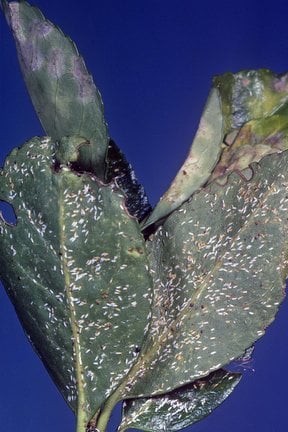
Quick facts
Common name - Hydrangea scale
Scientific name - Pulvinaria hydrangeae
Plants affected - Hydrangea, Acer,Prunus and others
Main symptoms - White oval egg masses on the stems and foliage
Most active - May-August
What is hydrangea scale?
Hydrangea scale is a sucking insect found on hydrangeas but can also feed on other woody plants including Acer and Prunus. Affected plants can suffer a lack of vigour and leaf loss caused by the insect sucking sap from the foliage and stems. This is one of many types of scale insects encountered by gardeners.
Scale insects are sap sucking true bugs belonging to several families in the Hemiptera. Typically the adults are immobile having a flattened or raised appearance, with no visible legs. They often look like a ‘scale’ on a leaf or stem, many species produce a white wax often covering egg masses. There are more than 100 species found in Britain, 26 of which have been introduced. More than 25 species can be found in gardens or on houseplants.
Symptoms
The immature scales (nymphs known as crawlers) are difficult to see and the presence of these insects becomes apparent in early summer when the adult scales deposit eggs on the stems and leaves. You may see:
- Eggs which are covered in white waxy fibres that form smooth, oval patches 3-4 mm long. These white patches will persist on the plant long after the eggs have hatched
- Newly hatched scales (crawlers) are less than 1 mm long and are pale yellow
- The crawler stage can be distributed in wind currents
- The mature scales are around 3 mm in diameter, oval in shape and brown
- Heavily affected plants lack vigour and may shed leaves
Management
- Where possible tolerate populations of scale insects. Well-tended healthy plants are able to tolerate light populations of these insects and so they do not necessarily require management
- Encourage predators in the garden, some ladybirds , parasitoid wasps and some birds will eat scale insects
- Adult scales and egg masses can be removed when seen but this may not reduce large populations
- Heavily affected plants can be removed and replacements planted in the autumn
Biology
Hydrangea scale is a -sucking insect that develops on the underside of leaves on Hydrangea and some other plants.
There is one generation a year with young nymphs hatching from eggs in mid-summer and sucking sap from the undersides of leaves. In late summer the nymphs move to the stems where they overwinter before maturing in late spring. Eggs are deposited under a covering of white waxy fibres in early summer.



















